While driving through the region of Istria, on our two week tour of Croatia, we saw a picturesque fortified village atop a mountain, which ascends about 886 feet above sea level. This was the village of Motovun, with a population of only about 500 people, where we would stay for a couple nights. It was a fascinating village, and I highly recommended that anyone visiting Istria should stop here for a visit.
The history of Motovun extends back to the ancient Celts and Illyrians, who both constructed fortresses at this location. Even its name is of Celtic origin, derived from the term "montona" which basically means "a town in the hills." The Romans also had a settlement here, and you can find a couple ancient Roman gravestones within Motovun. During the 10th and 11th centuries, Motovun belonged to the Bishop of Poreč. In 1278, the village and region were taken over by the Republic of Venice, which eventually built thick stone walls to fortify the village. Those walls remain, providing a more medieval ambiance to the village.
As I've mentioned before, Istria was known by the Romans as "Terra Magica," the land of magic, and Motovun fits within those mystical legends. For one, it's claimed that Motovun sits at the intersection of three mystical ley lines, known in Istria as "dragon lines." These are allegedly straight lines of mystical energy that connect important landmarks. The intersection of these lines is said to be located underneath St. Stephen’s church tower, and they allegedly provide Motovun with much positive energy. These lines extend to other villages, including Grožnjan and Opatalj, as well as some nearby megalithic circles, stone circles, in places including Picuge and Modele.
Breakfast is freshly made each morning in their kitchen, and you can watch their cook preparing it. One morning, they made Fritule, basically Croatian fritters or doughnut holes, and they were delicious. A slightly crunchy exterior with a light, fluffier interior. And both mornings, I enjoyed Scrambled Eggs with Truffles. Motovun is in the center of the truffle region of Istria, so truffles are found throughout Motovun's shops and restaurants.
As you can see, most of the narrow streets are made of cobblestones. The only vehicles permitted on the streets generally belong to residents. So, tourists need to park at the bottom of the village, and then walk into it. Motovun also is popular with cyclists, although you might not think cobblestones would be the best surface for riding a bicycle.
To the left of this medieval archway is the Mirna River valley. Within the archway, which is located on one of the main streets, there are a number of intriguing carvings (shown below), and coats of arms, most from the 15th century.
I passed through this archway a number of times as I explored Motovun.
The Bell Tower, which was constructed in the 13th century, is 27 meters tall and was built to be an observation tower, eventually becoming a bell tower. It is a very noticeable landmark, extending high into the air, and easily seen from outside the village.
Mario Andretti, the famed race car driver, and his twin brother, Aldo, were born in Motovun on February 28, 1940. There's a plaque commemorating his birth home. I actually stumbled on this place while wandering around Motovun, although I had known Andretti was born in the village.
Also while wandering, I found this little food stall, which made Fritule, Granita, Palačinke and Pommes Frite. I ordered some Truffle Honey Fritule, which cost about $7 US, and they were excellent, with a nice sweetness and the addition of an earthy taste from the truffle flavor.
There were a couple art shops too. Tanjur sells WallWare, decorative plates made for hanging on your wall, and not for your table. They have a large selection of pictures, from sea life to birds, anatomy to butterflies. The two-plate Lobster initially caught my eye, and I found many cool plates within the store. Art in Situ is a small art studio, operated by Kristina Micanovic & Igor Mudronja, which produces original artwork, t-shirts, bags and more. I was intrigued by their work, and even ended up buying one of their bags, with a fantasty sea-creature on it.
A wine shop, which also sells truffles and grappa.
The Aura Distillery, which produces Istrian brandy, rakija, has a location in Motovun. They also make an assortment of jams and chocolates.
There are several restaurants in Motovun as well, including the Konoba Fakin, where we would dine, and I'll be writing about that experience in another article. In short though, it has a great view into the valley, and the food & wine were excellent.
Another legend of the Motovun area is that giants used to live in the region, and it is said that they built some of the villages, including Motovun, as well as the megalithic stone circles. As humans started moving into the area, the giants began to disappear, all except for one, Veli Jože. In 1908, author Vladimir Nazor wrote a famous tale of this friendly giant, and he has been commemorated in Motovun. A street is named after Veli Jože and there is also a mural in the village which depicts the giant.
These are views from Motovun looking out into the Mirna River Valley, a region surrounded by vineyards, forests, and other small villages. During our time in Motovun, we would visit one of the wineries in the valley, as well as go on a truffle hunt in one of the forests. More about both of these in future articles.
There are a number of feral cats in Motovun, and you'll often find them near the restaurants, hoping to be fed, or waiting for food to drop to the ground. Above, one of the cats walks atop a wall, and the other side is a long drop to the ground. The cats are fairly friendly, especially if you feed them. I wonder how many truffles these cats eat.









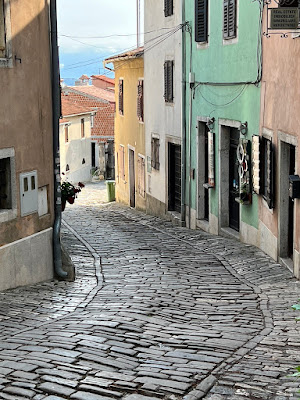







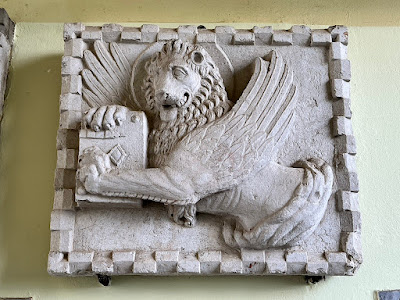








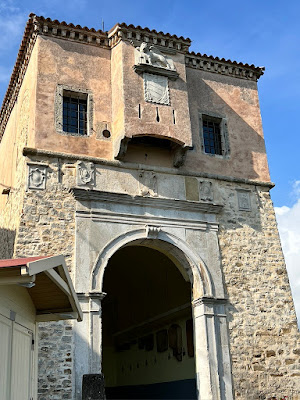













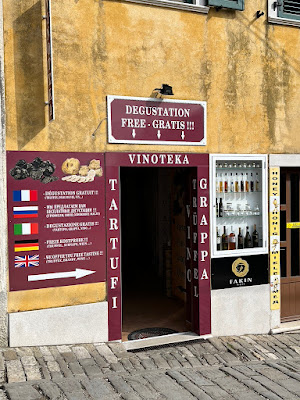

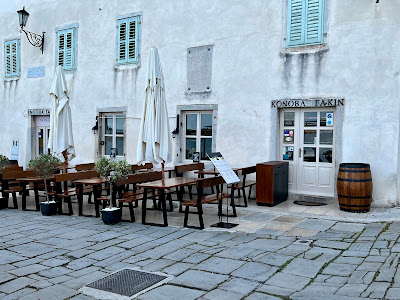










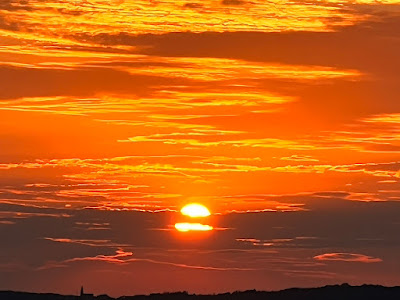

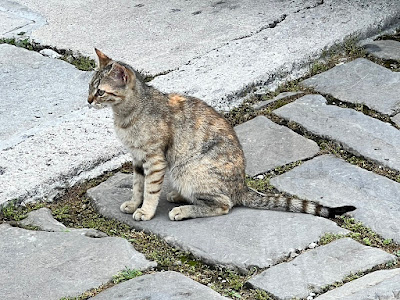





1 comment:
Great article! So interesting, so intriguing! It makes me want to visit Motovun tomorrow!
Post a Comment